Exploiting SWIPT–Enabled ARQ–Based Bidirectional Cellular IoV Spectrum Sharing Protocol and Its Performance Analysis
Abstract
A new spectrum sharing protocol with simultaneous wireless information and power transfer (SWIPT) is proposed to cope with the increasingly prominent problem of spectrum and energy scarcity. It operates within a cognitive radio network (CRN) in the context of cellular IoV (C-IoV), enabling bidirectional communication between two vehicles parked within the base station coverage (VnBSs) while facilitating cooperation for a pair of primary users (PUs), i.e., VnBSs can act as relays to provide cooperation communication for the cell–edge vehicle user (eVU). Unlike most existing work, both VnBSs can use time switching (TS) to obtain energy from radio frequency (RF) signals emitted from the base station. In order to enhance the reliability of the network, this study incorporates the automatic repeat request (ARQ) technique in the CRN supported by the nonorthogonal multiple access (NOMA) and SWIPT, which has not been performed in other works. Based on this, the transmission is divided into one energy harvesting (EH) phase and three information processing (IP) phases. A new packet for PUs is transmitted in the first IP phase and is allowed to be retransmitted twice in the last two IP phases depending on the decoding. VnBSs act as relays to obtain energy in the EH phase to assist in retransmitting the PU’s packets and sending their own packets in the last two IP phases. The system states are analyzed by building a one-dimensional Markov chain, and the end-to-end outage probability (OP) is calculated for each state under the Nakagami-m fading channel. Using these two results, the OP of the primary and secondary networks, system throughput and energy efficiency (EE) are derived. Finally, the validity of the derived results is verified by Monte Carlo simulation using MATLAB and compared with the protocol without ARQ, and the protocol proposed shows a better performance.
1. Introduction
In the fifth generation of wireless networks, the internet of things (IoT) spectrum sharing technology is a very promising technology that enables automated devices to establish communications for IoT applications within the authorized spectrum [1]. IoT integrates a variety of physical entities, including smartphones, smart furniture, sensors, and vehicles. [2]. They are connected through communication networks to facilitate the exchange of information between themselves and their surroundings. The IoT is consolidated IoV [3], a communication system that integrates vehicles with people, roadside units, intelligent sensors, and other networks [4]. To enhance user experience and service quality, vehicles must gather and analyze intricate traffic information in real time, even from considerable distances. This presents a significant challenge for energy-constrained and distance-limited cell–edge vehicle users (eVUs). On the other hand, with the progress of society and the development of science and technology, the cost of automobile manufacturing is gradually reduced, and the number of vehicle users is increasing explosively, which makes the limited road and spectrum resources more tense [5]. This urges us to study and design new spectrum sharing protocols to further improve the utilization of available resources.
To address the above issues, we conduct an in-depth analysis of the existing work on the background of IoV and the existing work on IoT general scenarios that can be applied to IoV. The results prove that cognitive radio (CR), nonorthogonal multiple access (NOMA), and simultaneous wireless information and power transfer (SWIPT) technologies can provide effective solutions to improve the spectrum efficiency (SE) and energy efficiency (EE) of IoT/IoV. The authors in reference [6] proposed a cluster-based CR–assisted vehicular network (CRAV-Net) to improve SE and congestion perception. In [7], the authors proposed two cooperative spectrum sharing protocols. The protocol used a mixture of underlay and overlay to provide secondary users (SUs) more opportunities to access the spectrum, thereby improving spectrum utilization. In addition, they enhanced system reliability through automatic repeat requests (ARQs). While the scheme in [8] greatly increases the system throughput by combining CR and NOMA techniques, the authors in [9] studied the performance of the overlay cognitive NOMA network under the Rayleigh fading channel and compared it with the performance of the overlay cognitive OMA network and underlay cognitive NOMA network. The results show that the overlay cognitive NOMA network performs the best. In addition, the integration of SWIPT in NOMA systems has been recognized as a potential paradigm for enhancing the lifetime of energy-constrained IoT/IoV networks [10]. In [11], the authors proposed a SecGreen scheme with an efficient energy harvesting (EH) algorithm. The SecGreen scheme maximizes EE by using SWIPT. The results show that the EE of the proposed scheme is improved by 22.5% and 20.34%, respectively, compared to the other two schemes. In [12, 13], the authors investigated the system of SWIPT technology integrated with cooperative NOMA. They utilized dedicated relays and user relays to facilitate communication for distant users, aiming to enhance the performance of remote users. In addition, the integration of SWIPT with NOMA technology exhibits versatility in its applicability to various communication scenarios. In the unmanned aerial vehicle (UAV) communication scenario of [14], the authors studied two cooperative NOMA communication networks based on time switching (TS) and power splitting (PS), respectively. The authors in [15] applied SWIPT and cooperative NOMA techniques to heterogeneous networks (HetNets). Unlike other literature, they considered not only superimposed signals from macrobase stations (MBSs) but also interfering signals from neighboring small-base stations (SBSs) for EH with good results. In addition, in order to solve the interruption and fair data rate problems of cell–edge users, the authors in [16] investigated the performance of cell–edge users in multiple input single output NOMA (MISO–NOMA) systems and proposed a SWIPT protocol that hybridizes TS and PS for powering the relay. In [17], the authors implemented ARQ technology in the NOMA network with the EH relay for the first time, enhancing system reliability. In addition to integrating the two technologies, some experts have begun to study the organic combination of the three technologies. The authors in [18] researched a cooperative spectrum sharing transmission scheme with EH customized for IoT applications. In the protocol described in [19], the primary transmitter (PT) leverages the secondary transmitter (ST) serving as an IoT relay to facilitate communication with users experiencing poor signal reception. In a cooperative network with SWIPT, the CR relay uses a PS scheme to obtain transmit power from the ST. In the protocol discussed in [20], the SWIPT–NOMA strategy in cooperative CR networks (CRNs) introduces a minor degradation in overall outage performance relative to similar protocols utilizing dedicated batteries, while maintaining the same diversity order.
It is found that there is little work to consider the application of CR, NOMA, and SWIPT technologies in IoV to vehicle communication. While there are many related works in IoT that can realize direct communication between users under the architecture of device-to-device (D2D) communication [21], and IoV is implemented based on IoT, devices in IoT also include mobile vehicles [22]. Therefore, when analyzing the related work aiming at improving the spectrum utilization and data confidentiality of vehicle communication, the related work of IoT general scenario suitable for IoV is also considered. For example, a bidirectional DF strategy based on two-phase network coding has been proposed in [23]. In [24], the authors investigated a scenario in which two IoT devices act as relays to assist a pair of primary users (PUs) in CRNs. The IoT relay device harvests energy using the TS protocol and subsequently utilizes the NOMA protocol to exchange its own information while forwarding the PU’s information. The authors in [25] analyzed the performance of a two-way relay system using SWIPT under Nakagami-m fading channel. The bidirectional communication between two nodes is accomplished through three phases, where the relay relies on the PS strategy to EH in the first two phases and amplify-and-forward (AF) the information from the node in the third phase. The authors of [26] designed a new SWIPT scheme with hybrid PS and TS to achieve bidirectional communication between PUs and SUs through four phases. These literature give useful references in terms of protocol design regarding the fusion of the three techniques in the context of vehicle communication. In [27], a Lagrangian dyadic algorithm based on a first-order Taylor series expansion function is proposed to solve the transmit power optimization problem to maximize the EE of SU. To achieve in-band bidirectional D2D/vehicle-to-vehicle (V2V) communication, the authors of [28, 29] utilize CR to enable devices to share the licensed spectrum of the PU and rely on the SWIPT technique to power the devices. The simulation results in [28] illustrate the SE and EE advantages of this system over unidirectional relaying. Simulation results in [29] show that the system achieves about 68% and 277% gains in SE and EE, respectively, compared to another spectrum sharing system for two-way communication. Similarly, in [30], the authors examined the performance of AF and DF relaying techniques in networks supporting D2D communications using CR and SWIPT methods. The results show that the proposed spectrum sharing protocol improves the performance of DF relaying and AF relaying schemes by 209% and 49%, respectively. Therefore, the collaboration of D2D communication users as relays for data transmission can significantly enhance system performance by sharing the bandwidth utilized by cellular base stations [21]. In addition, the authors in [31] have also proved that using roadside parked vehicles as relays within cellular networks, that is, by leveraging the vehicle’s onboard connectivity capabilities and turning them (when parked) into vehicle relay nodes, can monitor operating costs and increase network coverage and capacity. As a result, it is feasible to use parked vehicles with wireless functions as relays, and it is more capable of overcoming the exponential growth of user data requirements than traditional fixed-base deployments.
As mentioned above, considering CRNs with SWIPT two-way V2V relay cooperation in the context of cellular IoV (C-IoV) has significant implications for SE and EE improvement. However, the OP increases in [20]. Furthermore, most studies are conducted under Rayleigh channels, and none of them has applied the ARQ technique to SWIPT–enabled CR–NOMA networks. Therefore, considering the key constraints of C-IoV deployment, this study proposes a DF–based bidirectional cooperative CRN that leverages the benefits of NOMA and SWIPT technologies, as shown in Figure 1. In this scenario, a pair of vehicles parked within base station coverage (VnBSs) harnesses energy from radio frequency (RF) signals using the TS technique. The harvested energy is then employed to facilitate relay cooperation with PU, while also supporting its own information exchange requirements. To incorporate ARQ, the information processing (IP) phase is divided into three parts and the PU is fixed to transmit new packets using the IP-1 phase. If PU successfully decodes, VnBSs are granted exclusive spectrum access for subsequent information exchange in the later phase. However, if PU fails to decode, VnBSs are prioritized for retransmission on behalf of PU and can simultaneously transmit their own information using the NOMA technique. Hence, in contrast to the cooperative scheme lacking ARQ, the protocol presented in this paper not only addresses the reliability concerns of PUs but also enhances spectrum access for VnBSs, thereby improving VnBSs′ communication quality while ensuring PU’s quality of service (QoS). Ultimately, due to its comprehensive nature and compatibility with various experimental data, we opt to employ the Nakagami-m fading channel model. Thus, in contrast to [9], the Nakagami-m fading channel model used in this paper offers a more realistic representation than the Rayleigh fading model. In addition, the CR–NOMA framework discussed here supports the integration of SWIPT and ARQ technologies, which is not addressed in [9]. Since the network architecture discussed in [9] is a typical CR system with a PUs pair and a SUs, it is consistent with the network architecture studied in this paper. Therefore, during the application of the above two technologies, the spectrum sharing scheme adopted by VnBSs as a cooperative relay to assist PU transmission utilizes the results of [9], i.e., the overlay spectrum sharing scheme is adopted. Thus, the performance of this scheme is compared with that of [9] during the numerical simulation process.
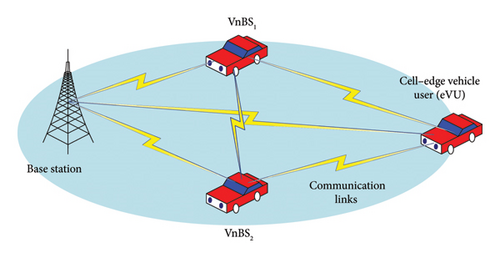
- •
A DF–based bidirectional cooperative CRN model is established that utilizes NOMA and SWIPT technologies for a new spectrum sharing protocol, where VnBSs harvest energy from RF signals using the TS technique to facilitate relay cooperation and conduct their own information exchange, thereby improving SE and EE.
- •
The ARQ technique is applied to the cognitive NOMA network supported by SWIPT. Based on the feedback from PR and VnBSs, the system can employ varied retransmission strategies. To facilitate communication between primary and secondary systems, the transmission is divided into four phases, comprising one EH phase and three IP phases. If PU successfully decodes its own information in the IP-1 phase, VnBSs can exclusively utilize the remaining two phases for their own information exchange. If PU fails to decode, retransmission of PU’s information will occur in the subsequent two phases following a specific order: I VnBS1, VnBS2, and PT based on VnBSs′ decoding status until both retransmission opportunities are exhausted. This scheme enhances spectrum access opportunities for SUs, optimizes spectrum utilization, and bolsters the reliability of the primary network.
- •
A one-dimensional Markov chain is established to analyze the system’s performances by examining the system state change. We derive the end-to-end outage probability (OP) and utilize it, along with the Markov chain, to obtain the OP, system throughput, and EE of both the primary and IoV systems. Ultimately, numerical simulations of the system performances demonstrate the impact of certain parameters. Furthermore, compared to the protocol without ARQ, our proposed protocol exhibits superior performance. It addresses the reliability issue of PUs and provides additional spectrum access opportunities for VnBSs, ensuring high-quality PU service and enhancing communication quality for VnBSs.
The remaining components of the paper are as follows: in Section 2, the system model and protocol are shown. Through the description in this section, the transmission process and the state transition relationship can be clearly understood. In Section 3, the system performances are analyzed. In order to analyze the system state, a one-dimensional Markov chain is also established in this section. Numerical simulations are presented in Section 4. Finally, the study is concluded in Section 5.
2. System Model and Protocol Description
Figure 2 depicts the bidirectional CR system supported by NOMA and SWIPT considered in this paper. PUs comprise a base station serving as the PT and a eVU functioning as the PR. In particular, cell–edge users are those located far from the base station, positioned at the edge of the network coverage area. Therefore, in this paper, a mobile vehicle with the above characteristics is regarded as eVU, and the influence of distance and multipath propagation effect on signal strength is characterized by channel fading. An eVU obtains traffic information through the base station to avoid traffic congestion and traffic accidents, so as to make early lane changes or other driving decisions. However, the direct link between the base station and eVU is hindered by factors such as distance and fading. A pair of close VnBSs in the cell act as relays to assist the PU in retransmission. By aiding services to the PU, VnBS1 and VnBS2 can complete mutual communication on the PU’s licensed spectrum. All participating nodes, including the primary system and the IoV system, are equipped with a single antenna and operate in half-duplex.
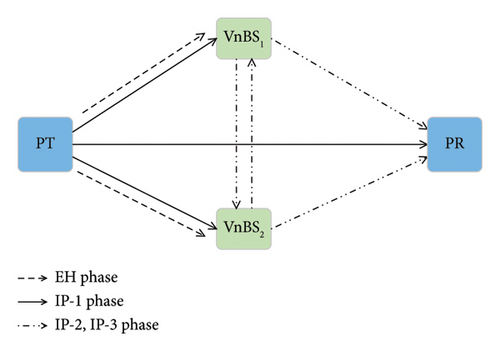
In order to complete the communication between the primary system and the IoV system and consider the power supply of the relay, the TS–based SWIPT technology is used. The transmission process is divided into two phases: EH and IP, with the IP phase further segmented into three phases, as depicted in Figure 3. In the EH phase, unlike other literature, both VnBSs are capable of harvesting energy from the RF signal transmitted by PT in order to facilitate the transmission of PU and their own information in the subsequent phase. In the IP phase, ARQ is incorporated into this protocol to enhance the transmission reliability of PU, allowing for up to 2 retransmissions by PU while prohibiting any retransmissions by VnBSs. In the IP-1 phase, PT broadcasts the primary signal. Based on the feedback from PR and VnBSs (ACK for successful decoding and NACK for unsuccessful decoding), the system switches to the appropriate state at the IP-2 phase. If PR decodes the primary information successfully, VnBSs exclusively enjoy the next two phases to complete the information exchange under interwave mode. If PR fails to decode, VnBSs will assist PU to complete information exchange under overlay mode. Since VnBS1 wants to communicate with VnBS2 first, VnBS1 is used as the preferred relay. If the VnBS1 succeeds in decoding the primary information in the IP-1 phase, the PU’s signal is retransmitted by VnBS1; otherwise, it is retransmitted by VnBS2. If none of the VnBSs decode the primary information successfully, PT retransmits by itself. According to the feedback of PR in the IP-2 phase, the system is transferred to the corresponding state in the IP-3 phase. If the first retransmission of PR is successful, the system continues to complete the transmission of IoV. If the first retransmission of PR is unsuccessful, the second retransmission is performed in the IP-3 phase in the order of retransmission.
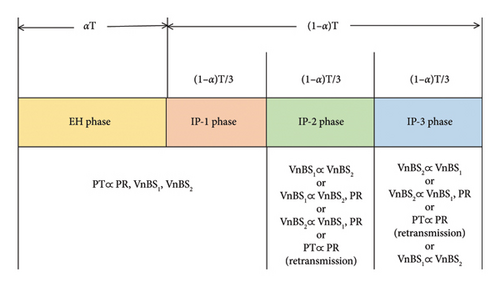
Having established the system model as outlined above, we will proceed to present the channel model and subsequently provide a detailed description of the protocol based on it. The specific system states and the transition relationships between states will also be analyzed in Section C (IP phase), while the signal-to-interference and noise ratio (SINR) of the corresponding link is calculated for the analysis of the system performance in Section 3.
2.1. Channel Model
2.2. EH Phase
2.3. IP Phase
In order to accomplish the communication of the PU and the bidirectional communication between the VnBSs in a single transmission, the IP phase is divided into three parts. The PU fixedly occupies the IP-1 phase to broadcast the primary signal, and the system will turn to different states according to the feedback from PR and VnBSs. In the next two phases, VnBSs act as relays to complete the retransmission of the primary system and the communication of the IoV system at the same time, or the primary signal is retransmitted by PT. According to the SWIPT transmission structure in the proposed protocol shown in Figure 3, the description of the specific transmission process of the system and the division and composition of each state are shown in Table 1.
| IP-1 (S1: PT ⟶ PR, VnBS1, and VnBS2) | IP-2 | IP-3 | ||
|---|---|---|---|---|
| PR | VnBS1 | VnBS2 | ||
| ACK | ACK/NACK | ACK/NACK | S2: VnBS1 ⟶ VnBS2 | S3: VnBS2 ⟶ VnBS1 |
| NACK | ACK | ACK | S4: VnBS1 ⟶ VnBS2 and PR | S3 |
| S5: VnBS2 ⟶ VnBS1 and PR | ||||
| ACK | NACK | S6: VnBS1 ⟶ VnBS2 and PR | S3 | |
| S7: PT ⟶ PR (retransmission) | ||||
| NACK | ACK | S8: VnBS2 ⟶ VnBS1 and PR | S9: VnBS1 ⟶ VnBS2 | |
| S7 | ||||
| NACK | NACK | S10: PT ⟶ PR (retransmission) | S9 | |
| S7 | ||||
- 1.
PR decodes xp successfully in IP-1 phase. VnBSs exchange their information in the next two phases. Then, the system first enters the State S2 (S2: VnBS1 ⟶ VnBS2) in IP-2 phase, and VnBS1 sends the signal x12 to VnBS2, and the signal received by VnBS2 is denoted by
() -
where P1 is the transmit power of VnBS1 given by equation (4). The decoded SINR at VnBS2 can be expressed as
() -
where ρ1 = P1/σ2. Then, the system will enter the State S3 (S3: VnBS2 ⟶ VnBS1), and after this state with probability one,VnBS2 sends a signal x21 to VnBS1. The signal received by VnBS1 is expressed as
() -
where P2 is the transmit power of VnBS2, which is given by equation (4). The decoded SINR at VnBS1 is denoted by
() - 2.
PR fails to decode xp in the IP-1 phase, but all the VnBSs decode xp successfully. VnBSs utilize NOMA technology to transmit their own signal while assisting PU in retransmission. As VnBS1 is the initiating party for communication, it is specified that if VnBS1 successfully decodes xp, it will transmit it first; otherwise, VnBS2 will retransmit it. If VnBS1 successfully decodes xp, the system will transition to State S4 (S4: VnBS1 ⟶ VnBS2 and PR), and VnBS1 will transmit the superimposed signal using NOMA. Due to the close proximity of VnBSs, a2 > a1, resulting in a higher power allocation to the PU’s signal, the retransmission signal received by the PR from VnBS1 is denoted as
() -
Since the PU’s signal is a strong power signal, PR will treat the VnBSs′ signal as interference and decode its own signal directly, and the decoding SINR is represented as
() -
The signal received by VnBS2 is expressed as
() -
Since the signal of VnBS2 is a weak power signal, it must use successive interference cancellation (SIC) to decode the signal of the PU first, and then decode its own signal after removing it. The SINR at VnBS2 is given by
()() -
The system will enter State S3 if this retransmission is successful; otherwise, it will enter State S5 (S5: VnBS2 ⟶ VnBS1 and PR).
-
Since the first retransmission of VnBS1 fails in State S4, the second retransmission is performed by VnBS2 in State S5. VnBS2 uses NOMA to send a superimposed signal , where b2 > b1, and the signal received by the PR can be represented as
() -
The decoding process is similar to the case of State S4, except that the roles of VnBS1 and VnBS2 are swapped. PR can directly decode its own signal, and the decoding SINR is expressed as
() -
The signal received by VnBS1 is denoted by
() -
SIC is used at VnBS1 to decode the signal of PU first, and then decode its own signal after removing it, and the decoded SINR is denoted as
()() - 3.
PR fails to decode xp in IP-1 phase, VnBS1 decodes it successfully but VnBS2 does not. The successful decoding of VnBS1 triggers its retransmission in the IP-2 phase, placing the system in State S6 (interpreted as State S4). If this retransmission is successful, the system progresses to the IP-3 phase. However, if VnBS2 fails to decode, it must be retransmitted by the PT itself and the system enters State S7 (analyzed in the same way as state S1).
- 4.
PR fails to decode xp in IP-1 phase; VnBS2 decodes it successfully while VnBS1 fails to decode. The retransmission is initiated by VnBS2 during the IP-2 phase, while simultaneously transmitting its own information in State S8 (similar to the analysis of State S5). The initial retransmission is successful, transitioning the system into State S9 (similar to the analysis of tate S2). However, the first retransmission fails and the system enters State S7, which is retransmitted by PT itself.
- 5.
PR fails to decode xp in the IP-1 phase and none of the VnBSs decodes successfully. In the IP-2 phase, PU autonomously performs the initial retransmission, while the system is in State S10 (S10: PT ⟶ PR and retransmission). The situation of the IP-3 phase is the same as that of IP-3 in 4, and the system will enter State S9 if the first retransmission is successful; otherwise, it will enter State S7.
There exist some states with the same transmission among the above transmission states shown in Table 1, so their analyses are omitted from the results. However, they still cannot be regarded as the same state, such as States S6 and S4, State S8 and S5, and States S7, S10, and S1. Since being in different IP phases also means being in different retransmission states, their future state transfer results are distinct. On the other hand, they also cannot be considered as the same state for the sake of building a one-dimensional Markov chain correctly and simply.
Based on the above state transfer analysis and state space {S1, S2, ⋯, S10}, we get the following state transfer diagram (Figure 4), which establishes the Markov chain of the protocol proposed, and the flowchart of its dynamic change process is shown in Figure 5.
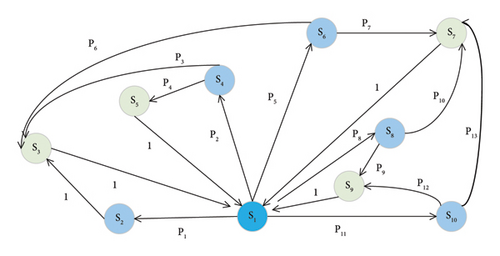
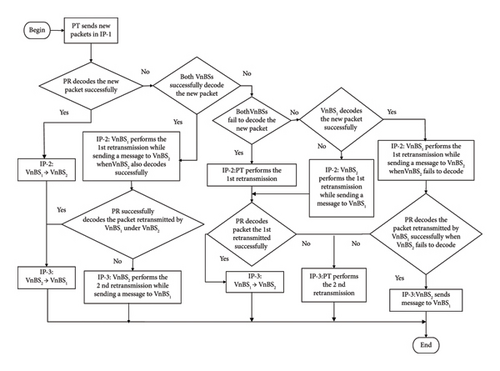
3. Performance Analysis
In this section, the performance of the implemented protocol is analyzed. The end-to-end OP in different states will be examined based on the transmission process and system state described in the previous section. Furthermore, utilizing the steady-state probabilities obtained earlier, the OPs of both primary and secondary systems can be calculated. In addition, by analyzing the OPs of primary and SUs, the system throughput and EE will be computed.
3.1. OP Analysis
- 1.
The OP of the primary system is as follows:
() - 2.
The OP of the IoV system is as follows:
()
3.2. System Throughput
3.3. EE
4. Simulation Result
In this section, Monte Carlo simulation is used to verify the accuracy of the analysis results. In order to discuss the effects of system parameters on OP, system throughput, and EE, the performance analysis of the proposed protocol is based on equations (35)–(37). In addition, in order to further highlight the advantages of the introduction of ARQ to improve system performances, a comparative analysis is made with the spectrum sharing protocol without ARQ in [9]. Therefore, the experimental parameters are set with reference to [9], as shown in Table 2.
| Parameter | Value |
|---|---|
| AWGN power | σ2 = 1 |
| Target rate | Rp = Rs = 0.5 |
| The power allocation coefficient of the NOMA scheme | a1 = b1 = 0.2, a2 = b2 = 0.8 |
| Energy conversion efficiency | η = 0.7 |
| Time switching coefficient | α = 0.1 |
| Distance between nodes | d12 = d21 = 0.51, dpr = 1, dp1 = dp2 = 0.8 |
| Path fading coefficient | α0 = 4 |
The comparison curves of PU in the protocol proposed in this paper and the protocol described in [9] are presented in Figure 6. Similarly, Figure 7 illustrates the comparison curves of SU in the protocol proposed in this paper and the protocol mentioned in [9]. It can be observed from the Figures 6 and 7 that the analysis results are basically consistent with the simulation results, thus verifying the effectiveness and accuracy of the analysis results. The analysis of the comparison curves in Figure 6 reveals a notable trend: as the transmission SNR increases, the OP for both PU and SU decreases. Specifically, it is evident from the Figure 6 that under the proposed protocol, the OP of PU is significantly lower than that of PU under the protocol [9], which does not incorporate ARQ technology. This discrepancy underscores the distinct advantages offered by employing ARQ techniques in enhancing system performance and reliability. In addition, the protocol described in this paper enables the PU to engage in up to two retransmissions, thereby significantly enhancing transmission reliability.
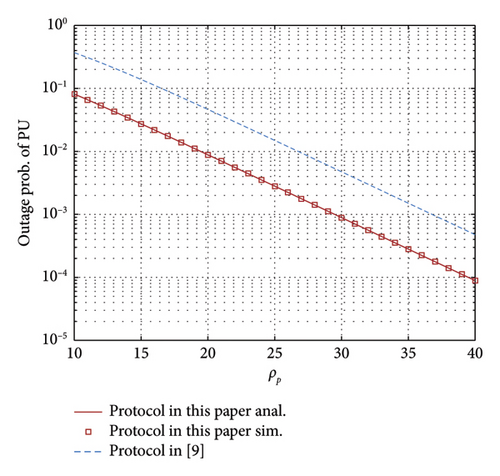
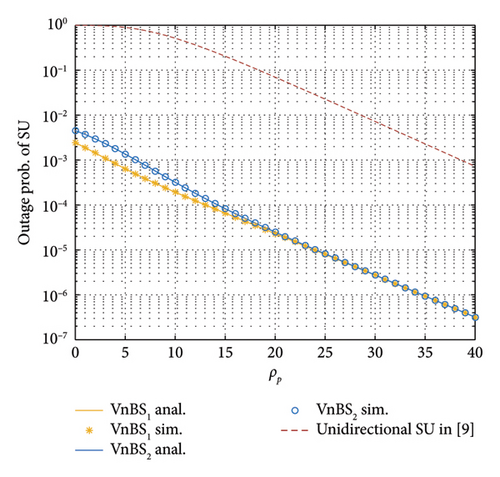
The analysis of Figure 7 reveals that the OP of SU, denoted as VnBSs, is lower under the proposed protocol compared to the SU’s OP in the protocol presented in [9]. This discrepancy can be attributed to the fact that in [9], the SU has an opportunity to transmit its own information while acting as a relay for PU only upon successful decoding of PU information. In this paper, VnBSs are employed to transmit their own information in the phase subsequent to successful transmission by PU. In addition, the study introduces a two-way relay system, effectively equivalent to having two relays. Following successful assistance in PU retransmission by one of the relays, the other is granted exclusive access to the spectrum irrespective of its success in decoding PU information. This approach enhances overall system efficiency and reliability while optimizing spectrum utilization. It is also evident that the OP of VnBS1 is marginally lower than that of VnBS2 at low transmission SNR. This discrepancy arises from the protocol’s specification that VnBS1, as the initiating party for communication, has greater access opportunities to the spectrum as the preferred relay compared to VnBS2. However, as transmission SNR increases, this gap gradually diminishes, indicating a relatively minor impact.
Figures 8 and 9 depict the relationship curves between transmission SNR and system throughput, considering varying target rates of Rp and Rs. These rates correspond to the fading parameters m = 1 and m = 1.5 of the Nakagami-m fading channel model. Here, Rp and Rs specifically represent the targeted data rates for PU and IoV users, respectively. As the transmission SNR increases, the system throughput increases continuously and starts to level off at ρp = 30 dB. In accordance with equation (36), the gradual reduction in OP is directly associated with a continuous increase in system throughput. This observed trend tends to stabilize at a specific point, known as the saturation point, which signifies the maximum achievable throughput under the given set of parameters. However, as the target rate increases, the system throughput increases, and it is more obvious at high SNR. According to equation (36), the increase in the target rate corresponds to the increase in the system throughput. Thus, as expected, the system throughput is basically consistent with the simulation results. As shown in Figures 8 and 9, when m = 1, Rp = Rs is 0.4, 0.5, and 0.6, respectively, and the maximum achievable throughput is about 0.8089, 0.8986, and 0.9884, respectively; when m = 1.5, the maximum achievable throughput is about 0.8252, 0.9190, and 1.0128, respectively. It is apparent that the system throughput at fading parameter m = 1 is lower than that at m = 1.5. This discrepancy can be attributed to the characteristics of the Nakagami-m fading channel model, where a larger value of the fading parameter m indicates reduced fading and improved channel conditions. Therefore, in this context, the higher system throughput observed at m = 1.5 compared to m = 1 reflects the influence of these differing channel conditions on overall system performance.
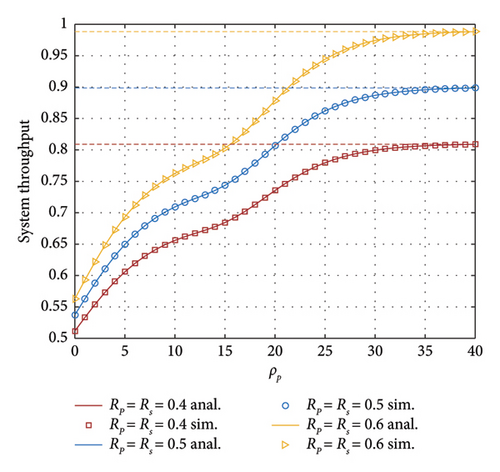
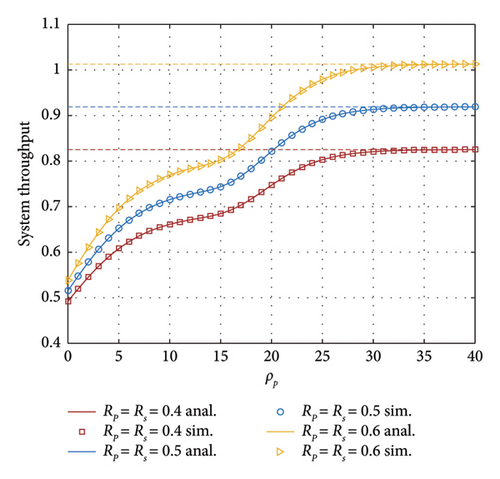
Figure 10 provides a visual representation of the relationship between EE and transmit signal-to-noise ratio (SNR) for different target rates. The Figure 10 reveals that the system exhibits significant EE at low SNR levels and small target rates. However, as both the transmit SNR and target rate increase, there is a noticeable decrease in EE. Interestingly, it is also observed that an increase in the target rate leads to an enhancement in the maximum achievable EE by the system. This suggests that while higher SNR and target rates may lead to reduced EE, increasing the target rate can potentially improve overall system performance in terms of EE.
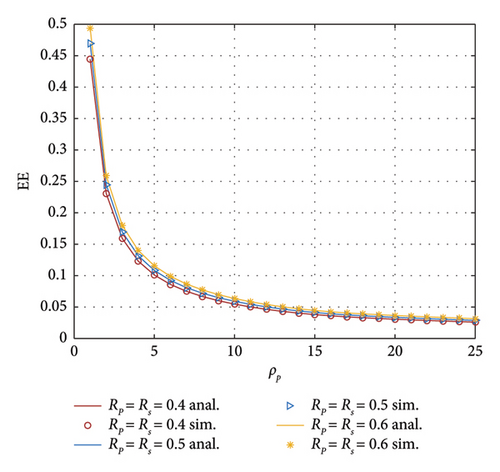
5. Conclusions
In this paper, we propose a bidirectional V2V communication scheme based on NOMA and SWIPT. Using CR technology, VnBSs can exchange information on the PU’s licensed spectrum alone or by assisting the PU. Second, the existing literature commonly increases the number of PU signal copies by allowing SU to transmit superposition signals containing both PU and its own information using NOMA. Subsequently, maximal ratio combining (MRC) or selection combining (SC) is employed at the receiver to enhance the reliability of PU transmission. However, this method results in low transmission quality for SU and introduces a certain degree of data redundancy, leading to unnecessary overhead. Hence, this study employs ARQ technology to significantly enhance the service quality of SU while ensuring successful PU transmission. Subsequently, we examine OP expressions for end-to-end, primary, and IoV systems, utilizing a one-dimensional Markov chain to analyze system states. In addition, system throughput and EE are investigated. Finally, the validity and accuracy of the analysis results are verified by Monte Carlo simulation, and the influence of some parameters on the system performance is revealed. The results show that with the increase in SNR, the system throughput tends to be saturated, that is, the maximum throughput of the system can be achieved. A comparative analysis shows that the proposed protocol outperforms protocols lacking ARQ functionality. Most importantly, in the proposed CR–NOMA network structure utilizing the SWIPT protocol, this paper innovatively combines ARQ technology with the concept that parked vehicles can be used as relays for cooperating cell–edge vehicle communication. This approach enhances traffic management and supports the deployment of C-IoV systems. In addition, the protocol architecture proposed in this paper is also applicable to the scenario of D2D communication in IoT.
However, in order to avoid the analysis being too complex and cumbersome, this paper simply regards the cell–edge vehicle as a vehicle far away from the base station and located in the edge area of the network coverage, regardless of its movement or not, as long as the above characteristics can be satisfied. Therefore, in future work, we will focus on mobile cell–edge vehicles and enable them to independently select the best relay. In this context, a relay refers to the available parked vehicles within the effective network coverage. The selection procedure will take into account the needs of edge vehicle users so as to improve the ability of traffic management of cellular vehicular networks and increase the application value of relay vehicles to be parked in cellular deployment. This approach aims to enhance traffic management capabilities in C-IoV and increase the practical value of parked relay vehicles within cellular deployments.
Conflicts of Interest
The authors declare no conflicts of interest.
Funding
This research was funded in part by the National Natural Science Foundation of China under grant no. 62467004, in part by the Hongliu First Class Discipline Development Project of the Lanzhou University of Technology under grant no. 25-225305, and in part by the Erasmus+ Programme of European Commission under grant no. 573879-EPP-1-2016-1-FR-EPPKA2-CBHE-JP.
Appendix A: The CDF of the Product of Two Gamma Random Variables
Open Research
Data Availability Statement
The data supporting this article are from previously reported studies and datasets, which have been cited.




